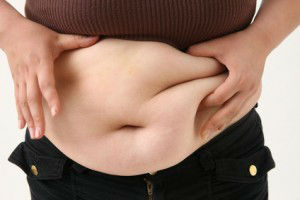
While excess body fat is not something you should make as your New Year’s resolution, if you happen to have a little extra, some places may be better to store your extra pounds.
People who carry most of their fat in their belly are known as “apple shaped,” while people who carry their fat in what is known as the gluteal femoral region, or butt and thigh area, are known as “pear shaped.” For years, researchers have investigated the possibility that not all fat is created equally. But what exactly is the lowdown on both types of fat?
Belly Fat
You’ve probably heard that excess abdominal fat increases your risk of a number of diseases including cancer, hypertension, and heart disease. But a recent study in the Journal of the American College of Cardiology was the first to use a CT scan to study specifically located fat deposits for direct associations with disease risk – confirming the dangers of belly fat.
In this study, the researchers were looking for the connection between the location of body fat and specific risk factors for heart disease and cancer, to explain why people with similar BMIs but different body types experience varied obesity related health conditions.
A lead author of the study, Caroline S. Fox, MD, MPH, noted, “contrary to previously published studies comparing BMI and waist circumference, the presence of abdominal fat improved the ability to predict for cardiovascular disease, supporting the hypothesis that abdominal fat may partially underlie the association of body fat and heart disease and cancer.”
This is significant in understanding the importance of reducing belly fat when it comes to better health. Because this visceral fat lies deep in the abdomen, surrounding organs and secreting toxic hormones, it contributes to the thickening of the walls of coronary blood vessels, which increases the chances of having a heart attack.
Your liver also suffers when you have too much belly flab. It has to work that much harder to filter out toxic substances. Women who are apple-shaped are also more likely to get certain cancers such as uterine, colon and breast cancer.
Another interesting study found that mid-life belly fat increased the risk of not only diabetes and heart disease but also Alzheimers. The study examined medical records of over 6,000 people who were members of Kaiser Permanente in Northern California from middle age into their 70’s and 80’s. Results indicated that those who had extra belly fat in their midlife were 3x more likely to develop dementia later in life.
Butt Fat
A study published by researchers at the University of Oxford and Churchill Hospital suggests that those who pack their extra pounds in their thighs and backside may have extra protection against diabetes, heart disease and other obesity-related health conditions.
According to study leader Manolopoulos, “The protective properties of the lower-body fat depot have been confirmed in many studies.” The results found that women with bigger rear ends have a lower level of cholesterol and are more likely to produce hormones that help break down sugar. In addition, having a big butt also requires an excess of omega 3 fats, which have been shown to catalyze brain development.
Researchers discovered that children born to women with wider hips are superior intellectually to children born to women with less lower body cushioning.
Dr. Michael Jensen, director of endocrine research at the Mayo Clinic noted that “If you look at people who have primarily the pear shape, they’re healthy in all the ways that this fat behaves. It’s not just less heart attacks or less diabetes, it’s all these ways we think about fat as an important organ for our health.”
Experts note that it is unclear as to whether or not fat in the hips and thighs makes one any healthier than being thin, as it is possible to be both healthy and thin. The thinking is, if you are going to have extra fat, it is best stored in your lower region, away from vital organs such as the heart, liver and kidneys.
The Final Analysis
Although it does seem that buttock and thigh fat is healthier than upper-body fat, where unburned calories are stored is mostly a matter of genetics. However, just because you have a pear shape is not a license to overeat and not exercise. No matter what your shape, eating a healthy diet and getting plenty of exercise is always the best path to health.
Eat Fat to Lose Fat
Just as unhealthy fats and refined foods contribute to the skyrocketing obesity rates in America, as well as rapidly expanding midsections, healthy fats are essential to boosting fat burning, and especially getting rid of visceral abdominal fat.
Be sure to include healthy fats in your diet from foods like:
- Virgin coconut oil and organic coconut milk
- Olive oil
- Raw nuts and seeds
- Avocados
- Wild-caught salmon
- Dark chocolate – at least 80% cacao
 In addition to including these healthy fats, follow these tips to say goodbye to that stubborn ab flab:
In addition to including these healthy fats, follow these tips to say goodbye to that stubborn ab flab:
- Participate in regular exercise, especially high intensity training that will boost metabolism and reduce fat.
- Build muscle through strength training exercise such as weight lifting, yoga or pilates.
- Practice meditation or deep-breathing exercises to relieve stress, as stress causes the body to stockpile extra pounds in the gut. When your body thinks a crisis is coming, it deposits fat cells into the belly because it’s the most convenient place to store them.
- Get plenty of rest. A lack of sleep causes the body to produce more of the hormones that increase appetite. Most people need 7 to 8 hours of sleep each night. Meditation just before bed and turning off electronics 30-60 minutes before bedtime can help induce a better night’s rest.
-The Alternative Daily
Sources:
http://www.universityherald.com/articles/5306/20131031/women-with-big-butts-are-smarter-and-resistant-to-chronic-illnesses.htm
http://www.ncbi.nlm.nih.gov/pubmed/23408348
http://share.kaiserpermanente.org/article/kaiser-permanente-study-shows-that-a-larger-abdomen-in-midlife-increases-risk-of-dementia
http://www.ncbi.nlm.nih.gov/pubmed/20065965

